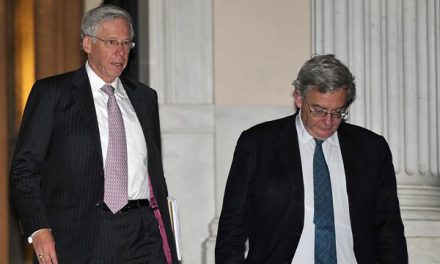In 2017, the U.S. economy had a solid year. Unemployment fell to a 17-year low, GDP growth picked up, and the stock market reached record highs.
Perhaps unsurprisingly, the Trump Administration was quick to take credit for these positive developments.
“The President’s economic agenda of lower taxes, less regulation, and more opportunity for all is already paying off,” said White House Press Secretary Sarah Huckabee Sanders in the first week of the new year.
Vice President Mike Pence echoed this view: “The President’s policies have been achieving extraordinary results,” he said on January 6.
And of course, the President himself, in a speech on January 8: “We’re seeing already — it’s very early — 11 months — the incredible results. … The American Dream is roaring back to life.”
Does the Trump Administration deserve the credit it has boldly claimed?
Any president’s ability to influence the $19 trillion U.S. economy is necessarily limited. The tendency on the part of politicians to claim credit or dole out blame for each day’s economic news is premised on a gross oversimplification of the world’s largest economy.
Nevertheless, a close look at the data suggests that most of the strong 2017 numbers actually reflect the continuation of ongoing trends that began under former President Obama.
The Obama Administration’s multifaceted response to the financial crisis will continue to be debated for years to come. Yet, given that the Trump Administration failed to enact any major economic policy legislation until late December, it is just as likely that the White House’s prior occupant – along with former Fed Chair Janet Yellen – set the stage for the U.S. economy’s continued gains in 2017.
You might not know it by listening to President Trump, but the U.S. economic situation during his first year in office looked an awful lot like it did in President Obama’s final year.
A Closer Look at the Economic Data
Let’s start with the labor market, a key dimension of the economy that is vital for the wellbeing of American families. The unemployment rate was 4.1% in December 2017, the lowest level since 2000. But unemployment had already reached a nine-year low of 4.6% in late 2016, and the decline since then is consistent with what has been observed in recent years.
During the Obama Administration, Republicans frequently dismissed reductions in the unemployment rate, arguing that fewer Americans were looking for work in the first place. Today, this criticism has seemingly vanished from the public debate, even though the labor force participation rate remains at 62.7%, exactly where it was at the end of 2016.
The total number of jobs added in 2017 – 2.2 million – was in line with the 2.3 million jobs added in 2016, while average hourly earnings for private-sector workers grew 2.7% in both 2016 and 2017.
What about GDP? Is the U.S. economy attaining the rapid growth rates that President Trump promised as a candidate?
Real GDP growth did indeed surpass 3% in the second and third quarters of 2017 – the first back-to-back quarters of 3% growth since 2014.
But for 2017 as a whole, the U.S. economy grew 2.5%, very close to the 2.4% rate projected by the Obama Administration in its final official forecast published in July 2016.
Furthermore, growth in 2017 was boosted by a resurgence in oil-related investment, as global oil prices began to rise again in mid-2017 after crashing two years ago.
The Trump Administration may argue that deregulation is partly to thank for rising domestic oil production. In fact, by the end of 2017, total U.S. oil output had merely returned to the 40-year high achieved in 2015, before oil prices fell.
Looking across a range of other economic indicators, some were up in 2017, while others were stable or down. Business investment grew more quickly than in 2016, but consumer spending growth was unchanged. Housing starts were up slightly, but motor vehicle assemblies fell. Expectations of a tax cut bolstered survey-based measures of business confidence, but commercial lending by U.S. banks grew at a subdued rate.
The trade deficit, one of President Trump’s frequent political punching bags on the campaign trail, has widened during the first year of the his administration. It stood at $50.5 billion in November 2017, up from $46.4 billion one year ago.
Overall, when it comes to the U.S. economy, it is difficult to see 2017 as a significant break from the recent past.
The Stock Market
Official economic data may not show much of a difference between President Obama’s final year and President Trump’s first year, but look at the stock market, Trump supporters say. Here, surely, we are seeing how President Trump has restored economic confidence and created trillions of dollars in new wealth.
“How’s your 401(k) doing?” the President has taken to asking in recent weeks.
If the answer is “well,” you should credit not just the 29% increase in the S&P 500 during the 15 months since the presidential election, but also the 166% increase during President Obama’s term up to that point. While there is no denying that the Trump Administration is off to a strong start on this metric, it remains to be seen whether the current bull market can be sustained.
Moreover, President Trump may try to take credit for recent stock market gains, but he will have to share it with economic policymakers around the world. Many S&P 500 companies are multinational firms with significant operations overseas. According to one estimate, more than 40% of S&P 500 company revenues are generated outside the United States. It is not surprising, then, that stocks in Europe and Japan have risen largely in tandem with the S&P 500.
Yet, too many Americans have no way to answer to President Trump’s question. Roughly half of American families do not own any publicly traded equities (either directly or indirectly), in large part because they lack access to employer-based retirement savings programs. Ultimately, rising stock prices will not be nearly enough to create broad-based prosperity for all Americans – especially in parts of the country where the economic expansion has yet to be fully felt.
Are We Better Off Than We Were One Year Ago?
The U.S. economy has continued to grow and stocks are up, but are Americans really better off after one year of President Trump? In fact, several concerning trends are already starting to take hold or worsen under the Trump Administration. Here are three:
First, fewer Americans have health insurance. After reaching historic lows under President Obama, the fraction of uninsured Americans began to increase in 2017, reflecting the Trump Administration’s repeated efforts to sabotage the Affordable Care Act. Comparing the fourth quarter of 2017 to one year prior, an additional 3.2 million Americans lacked health insurance, according to data from Gallup.
Second, the effects of climate change are growing more pronounced – as the President continues to question whether climate change is real. In 2017, the cost of extreme weather events in the United States exceeded $300 billion, the highest ever recorded, as a result of Hurricanes Harvey, Irma, and Maria, the wildfires in California, and a dozen other major episodes.
Nevertheless, after a December cold spell in the eastern United States, President Trump tweeted, “Perhaps we could use a little bit of that good old Global Warming.” Given the urgent need to make investments to both mitigate and adapt to climate change, Americans from Puerto Rico to California are left to hope that President Trump wakes up to reality sooner rather than later.
Finally, the budget deficit will become a bigger problem much sooner as a result of the tax law passed by Congressional Republicans and signed into law by President Trump. When President Obama left office, the deficit was projected to remain around 3% of GDP – a sustainable level – through 2020. This stable outlook offered a valuable window of opportunity for the next President to tackle America’s long-term fiscal challenge.
Instead, President Trump and the Republican-controlled Congress rushed through an expensive tax bill that by one estimate will raise the deficit to 5% of GDP as early as next year. Between larger deficits and the temporary provisions in the Trump tax law, Congress will almost certainly need to revisit tax policy sooner rather than later.
The Year Ahead
In the Trump reality show we all now inhabit, 2018 will be a revealing year.
A few large, high profile companies have already paid bonuses or promised wage increases in response to the tax law. Is a broad-based trend starting to take hold? Or are these announcements just savvy public relations efforts aimed at winning favor with an erratic President?
Will the tax law spur enough additional growth so that it pays for itself, as some have outlandishly claimed? Or will new loopholes cause higher deficits and more public borrowing?
Will the President’s tough talk enable diplomatic breakthroughs on trade and North Korea? Or will his dangerous rhetoric rattle investors and jeopardize the stock market highs he loves to tout?
My hope for the country is that these areas of major uncertainty will all turn out for the best. My fear – having watched season one of the Trump show – is that we could be in for a few unexpected twists.
**Matt Aks (HBS ‘18) worked in the Obama White House from 2011 to 2016. This article is based on data available as of February 2nd, 2018.


















